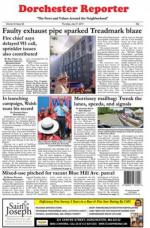July 28, 2016
The recent police shootings of Alton Sterling in Baton Rouge, Louisiana, and Philando Castile in Falcon Heights, Minnesota, have once again drawn national attention to the tension between law enforcement and communities of color. Here in Boston, recent polling indicates that a substantial majority of individuals believe that Boston suffers from the same kinds of problems as other cities when it comes to the police and people of color, and that nearly one in three black residents do not believe that the Boston police treat them fairly.
Although this tension and distrust stems from many sources, a fundamental problem is the lack of diversity in the Boston Police Department (BPD). Simply put, Boston is becoming increasingly diverse, but the BPD is not. With each passing year, BPD is looking less and less like the community that it serves and increasingly out of step with the racial and demographic composition of the city.
City officials profess that their hands are tied and that they cannot do more to increase diversity in the police force. However, the reality is that the city and the BPD are actively fighting efforts to diversify the police force. In fact, some of the greatest barriers to diversifying the department are created directly by the city.
In court cases, the city is aggressively fighting efforts to diversify the BPD. For example, in the case of Smith v. City of Boston, a federal judge ruled that a flawed lieutenants promotional exam discriminated against black and Latino officers. However, rather than resolve the issue of appropriate remedies for this discriminatory action, the city has fought against a settlement and is now appealing. Similarly, in Jones v. City of Boston, the city has been fighting to defend a discriminatory and scientifically unreliable drug-screening method that has resulted in the wrongful termination of a disproportionate number of black officers.
And in another case, Defay v. Boston Police Department, the Massachusetts Commission Against Discrimination ruled that the BPD discriminates against minority recruits in its disciplinary practices. The MCAD ordered BPD to “cease and desist” from this conduct.
Nevertheless, irregularities continue, and the Civil Service Commission has recently opened an investigation into why large numbers of high-scoring recruit candidates were bypassed, many without the proper legal notice.
Finally, the BPD is resistant to fully and freely informing the public of its practices, especially surrounding racial and demographic issues. The department refused to voluntarily disclose public records concerning the racial composition of its most recent recruit class, and the Lawyers’ Committee for Civil Rights had to file a public records lawsuit to secure the demographic data. The lawsuit uncovered that the most recent recruit class is 74 percent white and has no Asian or Latina women. (See Lawyers’ Committee for Civil Rights v. Boston Police Department, Suffolk Superior Court. No. 16-1075 (filed January 20, 2016.)
As these examples demonstrate, the city is actively impeding progress by fighting efforts to diversify the BPD by disproportionately disciplining minority recruits like Claude Defay and by shielding its practices from public scrutiny by refusing to comply with the public records law. Simply stopping these practices would help to diversify the police force.
Boston can and must do more to increase minority representation on the force if it is to gain community trust. The BPD must hire officers who reflect the communities they serve. Other solutions that could and should be adopted include: increased use of PAR10, the regulation that allows hiring of officers with language skills; proactive recruiting efforts in communities of color; and greater attention to retention of minority recruits and officers.
There is also a critical need for meaningful training on recognizing and confronting implicit bias. In doing so, the BPD should stop relying on “homemade” in-house trainings, and should draw instead upon law enforcement practices experts who have in-depth experience in this arena.
Boston is just one incident away from becoming another Ferguson or Baton Rouge. This can be avoided if the city takes proactive steps to get out in front of these issues.
Ivan Espinoza-Madrigal is the executive director of the Lawyers’ Committee for Civil Rights.


